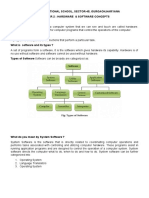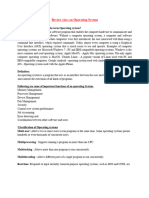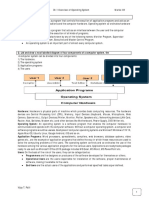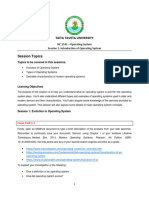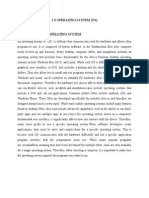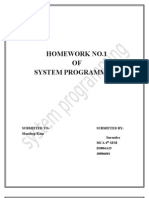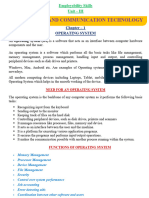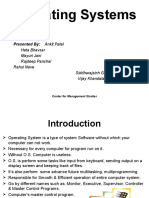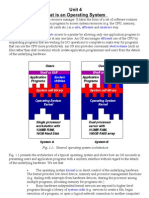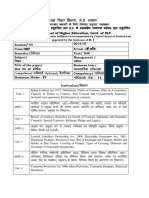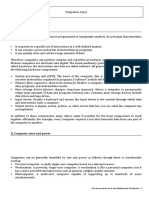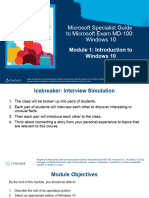Boot Application Program API GUI: What Is An Operating System? An Operating System (Sometimes Abbreviated
Boot Application Program API GUI: What Is An Operating System? An Operating System (Sometimes Abbreviated
Uploaded by
Garima GarimaCopyright:
Available Formats
Boot Application Program API GUI: What Is An Operating System? An Operating System (Sometimes Abbreviated
Boot Application Program API GUI: What Is An Operating System? An Operating System (Sometimes Abbreviated
Uploaded by
Garima GarimaOriginal Title
Copyright
Available Formats
Share this document
Did you find this document useful?
Is this content inappropriate?
Copyright:
Available Formats
Boot Application Program API GUI: What Is An Operating System? An Operating System (Sometimes Abbreviated
Boot Application Program API GUI: What Is An Operating System? An Operating System (Sometimes Abbreviated
Uploaded by
Garima GarimaCopyright:
Available Formats
What is an operating system?
An operating system (sometimes abbreviated
as "OS") is the program that, after being initially loaded into the computer by
a boot program, manages all the other programs in a computer. The other
programs are called applications or application programs. The application
programs make use of the operating system by making requests for services
through a defined application program interface (API). In addition, users can
interact directly with the operating system through a user interface such as a
command language or a graphical user interface (GUI).
An operating system performs these services for applications:
In a multitasking operating system where multiple programs can be
running at the same time, the operating system determines which
applications should run in what order and how much time should be
allowed for each application before giving another application a turn.
It manages the sharing of internal memory among multiple applications.
It handles input and output to and from attached hardware devices,
such as hard disks, printers, and dial-up ports.
It sends messages to each application or interactive user (or to a system
operator) about the status of operation and any errors that may have
occurred.
It can offload the management of what are called batch jobs (for
example, printing) so that the initiating application is freed from this work.
On computers that can provide parallel processing, an operating system
can manage how to divide the program so that it runs on more than one
processor at a time.
All major computer platforms (hardware and software) require and
sometimes include an operating system. Linux, Windows, VMS, OS/400, AIX,
and z/OS are all examples of operating systems.
Operating System types
As computers have progressed and developed, so have the operating systems. Below is a
basic list of the types of operating systems and a few examples of operating systems that
fall into each of the types. Many computer operating systems will fall into more than one of
the below types.
GUI - Short for Graphical User Interface, a GUI operating system contains graphics and
icons and is commonly navigated by using a computer mouse. See the GUI definition for a
complete definition. Examples of GUI operating systems are:
System 7.x Windows 98 Windows CE
Multi-user - A multi-user operating system allows for multiple users to use the same
computer at the same time and different times. See the multi-user definition for a complete
definition. Examples of operating systems that would fall into this category are:
Linux Unix Windows 2000
Multiprocessing - An operating system capable of supporting and utilizing more than one
computer processor. Examples of operating systems that would fall into this category are:
Linux Unix Windows XP
Multitasking - An operating system that is capable of allowing multiple software processes
to run at the same time. Examples of operating systems that would fall into this category
are:
Linux Unix Windows 8
Multithreading - Operating systems that allow different parts of a software program to
run concurrently. Examples of operating systems that would fall into this category are:
Linux Unix Windows XP
You might also like
- Chapter - 5 Operating SystemDocument6 pagesChapter - 5 Operating SystemAshish SharmaNo ratings yet
- List of Old Doordarshan TV Shows and Serials - AbhiSays PDFDocument21 pagesList of Old Doordarshan TV Shows and Serials - AbhiSays PDFGarima GarimaNo ratings yet
- Class-Viii A Roll No-40: Subject-ComputerDocument7 pagesClass-Viii A Roll No-40: Subject-ComputerSwati GuptaNo ratings yet
- Lec#8 ITCPDocument8 pagesLec#8 ITCPGhulam MustafaNo ratings yet
- Bhs Inggris Meet 3 - M Aldi Nur Qalbu - 17.2A.07Document2 pagesBhs Inggris Meet 3 - M Aldi Nur Qalbu - 17.2A.07Dapi DapiNo ratings yet
- Types of Operating SystemsDocument5 pagesTypes of Operating Systemsqscftbhnskmjjn89% (9)
- Introduction OSDocument1 pageIntroduction OSkumar_rajeev30No ratings yet
- Types of Operating SystemDocument10 pagesTypes of Operating SystemKishan MishraNo ratings yet
- Systems 2016Document3 pagesSystems 2016baggavirginNo ratings yet
- Operating System HandoutsDocument3 pagesOperating System HandoutsDamn SarucamNo ratings yet
- Introduction To Operating SystemDocument2 pagesIntroduction To Operating SystemTamilarasi SasivarnamNo ratings yet
- CHAPTER 2 Hardware Software ConceptDocument6 pagesCHAPTER 2 Hardware Software ConceptSeema Sehdev100% (1)
- 8 Different Types of Operating Systems With ExamplesDocument3 pages8 Different Types of Operating Systems With Examplestimothy pahaladNo ratings yet
- Topic One Introduction To Os in GeneralDocument21 pagesTopic One Introduction To Os in Generallilmickey628No ratings yet
- Operating System: What Do Operating Systems Do?Document14 pagesOperating System: What Do Operating Systems Do?Melissa Jane MoradoNo ratings yet
- Unit I: An Introduction To Operating SystemDocument12 pagesUnit I: An Introduction To Operating SystemLinda BrownNo ratings yet
- Operating SystemsDocument2 pagesOperating SystemsCIRIALNo ratings yet
- Operating SystemDocument5 pagesOperating SystemAnu GuptaNo ratings yet
- Objectives of Operating System: 1.convenienceDocument6 pagesObjectives of Operating System: 1.conveniencemaryamnasir72001No ratings yet
- Chapter 02 Operating SystemDocument27 pagesChapter 02 Operating SystemEshan HirushkaNo ratings yet
- Number Sysems Ops NetworkingDocument58 pagesNumber Sysems Ops NetworkingyoungallancoleNo ratings yet
- Computer SystemDocument6 pagesComputer SystemGerald TorrezNo ratings yet
- Operating SystemDocument2 pagesOperating Systemsadiasm125No ratings yet
- OSY UNIT 1Document35 pagesOSY UNIT 1janhavic811No ratings yet
- Operating Systems & Gui: in This Lesson Students Will: Get Familiar With The Following TermsDocument9 pagesOperating Systems & Gui: in This Lesson Students Will: Get Familiar With The Following Termskyu haiNo ratings yet
- LinuxDocument206 pagesLinuxDinesh Bhawnani100% (1)
- OsDocument18 pagesOsSonaliNo ratings yet
- What Is An Operating SystemDocument1 pageWhat Is An Operating SystemJesús ReyesNo ratings yet
- 5 Types of Operating Systems For ComputersDocument2 pages5 Types of Operating Systems For ComputersEduardo CasesNo ratings yet
- Operating SystemDocument37 pagesOperating Systemmhsinm2003No ratings yet
- Operating Systems (OS)Document2 pagesOperating Systems (OS)Daina MasicampoNo ratings yet
- FocusTaskReading 1Document16 pagesFocusTaskReading 1anniebabbie77No ratings yet
- Types of Operating SystemDocument7 pagesTypes of Operating SystemSYED AOUN ABBAS NAQVINo ratings yet
- 1.0 Operating System (Os) : Software Hardware Programs System Software Boot UpDocument6 pages1.0 Operating System (Os) : Software Hardware Programs System Software Boot Upazalea8902No ratings yet
- Homework No.1 OF System Programming: Submitted To: Submitted By: Mandeep Kaur Surendra Mca 4 SEM D3804A15 10806601Document9 pagesHomework No.1 OF System Programming: Submitted To: Submitted By: Mandeep Kaur Surendra Mca 4 SEM D3804A15 10806601Surendra Singh ChauhanNo ratings yet
- ITC 401 Lect Note2Document35 pagesITC 401 Lect Note24rgx7fmvg9No ratings yet
- Lecture 2 Computer ManagementDocument39 pagesLecture 2 Computer ManagementmeshNo ratings yet
- Operating System: Week 4Document9 pagesOperating System: Week 4Syed Amaan JafferyNo ratings yet
- HW1A3803 (368) Sys Prog (24 Last Date)Document8 pagesHW1A3803 (368) Sys Prog (24 Last Date)Surendra Singh ChauhanNo ratings yet
- Types of Operating SystemsDocument7 pagesTypes of Operating SystemsMebiratu BeyeneNo ratings yet
- Network Operating SystemDocument7 pagesNetwork Operating SystemRonnie AbaoNo ratings yet
- Operating Systems & Gui: in This Lesson Students Will: Get Familiar With The Following TermsDocument9 pagesOperating Systems & Gui: in This Lesson Students Will: Get Familiar With The Following TermsMeiNo ratings yet
- Employability Skills Unit - III ICT SkillsDocument23 pagesEmployability Skills Unit - III ICT Skillsabhistdoneria462No ratings yet
- Operating SystemDocument3 pagesOperating SystemMhiz Oluchukwu CynthiaNo ratings yet
- Operating Systems: Navigation SearchDocument5 pagesOperating Systems: Navigation Searchrahulkumar1234509No ratings yet
- Operating SystemDocument2 pagesOperating Systemsi324677No ratings yet
- An Operating System Is The Single Most Important Software When You Run A ComputerDocument4 pagesAn Operating System Is The Single Most Important Software When You Run A ComputerHamza NasirNo ratings yet
- Introduction To UNIX Shell ProgrammingDocument28 pagesIntroduction To UNIX Shell ProgrammingsvdonthaNo ratings yet
- Unix and Shell Programming - : Semester - IiiDocument77 pagesUnix and Shell Programming - : Semester - IiiMohan PatelNo ratings yet
- MD Apu (ID-32)Document9 pagesMD Apu (ID-32)Pranob NandiNo ratings yet
- Operating Systems: Presented byDocument42 pagesOperating Systems: Presented byneverahulNo ratings yet
- Unit 1 Chapter 1: Introduction: Operating System F.Y.Bsc - It Prof. Sujata RizalDocument31 pagesUnit 1 Chapter 1: Introduction: Operating System F.Y.Bsc - It Prof. Sujata RizalRAJESHNo ratings yet
- Lab 1 - IntroductionDocument77 pagesLab 1 - IntroductionYASH KAMRANo ratings yet
- CSC 112 - Lecture 1 (Os)Document11 pagesCSC 112 - Lecture 1 (Os)Abiodun JosephineNo ratings yet
- So - Aula 01Document4 pagesSo - Aula 01alineeduvirgensNo ratings yet
- CUET COMPUTER CLASS 01Document27 pagesCUET COMPUTER CLASS 01rahulrajdmh27No ratings yet
- ITM-Unix As An OSDocument29 pagesITM-Unix As An OSaakritib_1No ratings yet
- Different Types of Operating SystemsDocument2 pagesDifferent Types of Operating SystemsAnit Jacob PhilipNo ratings yet
- Lecture-14Document49 pagesLecture-14anurag_garg_20No ratings yet
- SPSA (Unix Notes)Document66 pagesSPSA (Unix Notes)Gaurav Leekha50% (2)
- Linux: A complete guide to Linux command line for beginners, and how to get started with the Linux operating system!From EverandLinux: A complete guide to Linux command line for beginners, and how to get started with the Linux operating system!No ratings yet
- Single To DoubleDocument4 pagesSingle To DoubleGarima GarimaNo ratings yet
- Bank Re-Conciliation QuesDocument3 pagesBank Re-Conciliation QuesGarima GarimaNo ratings yet
- Investment QuestionsDocument4 pagesInvestment QuestionsGarima GarimaNo ratings yet
- Semester Syllabus First and Second, Higher Education, Madhya Pradesh, IndiaDocument1 pageSemester Syllabus First and Second, Higher Education, Madhya Pradesh, IndiaGarima GarimaNo ratings yet
- Charles Babbage Charlie Gabbage Champs Babbage Dit-Doto Matrix Printer Ink Jet Printer Dot Matrix Printer Laser PrinterDocument1 pageCharles Babbage Charlie Gabbage Champs Babbage Dit-Doto Matrix Printer Ink Jet Printer Dot Matrix Printer Laser PrinterGarima GarimaNo ratings yet
- Library & UtilitiesDocument1 pageLibrary & UtilitiesGarima Garima100% (1)
- ProvisionsTable CompActDocument11 pagesProvisionsTable CompActGarima GarimaNo ratings yet
- Computer TypesDocument6 pagesComputer TypesGarima GarimaNo ratings yet
- Definition - What Does High-Level Language (HLL) Mean?Document1 pageDefinition - What Does High-Level Language (HLL) Mean?Garima GarimaNo ratings yet
- Bailment and PledgeDocument3 pagesBailment and PledgeGarima GarimaNo ratings yet
- Types of InsuranceDocument15 pagesTypes of InsuranceGarima GarimaNo ratings yet
- Tax Notes On Capital GainsDocument15 pagesTax Notes On Capital GainsGarima GarimaNo ratings yet
- List Ayurvedic Manufacturing UnitDocument15 pagesList Ayurvedic Manufacturing UnitGarima Garima50% (2)
- List of Old Doordarshan TV Shows and SerialsDocument21 pagesList of Old Doordarshan TV Shows and SerialsGarima GarimaNo ratings yet
- It Era Midterm Lessons and NotesDocument10 pagesIt Era Midterm Lessons and NoteslovelyjanedigayNo ratings yet
- Amoeba OS: Distributed SystemsDocument80 pagesAmoeba OS: Distributed Systemsbhadz_1718100% (1)
- Building Your Own Cybersecurity Lab A Step-by-Step Guide For BeginnersDocument6 pagesBuilding Your Own Cybersecurity Lab A Step-by-Step Guide For BeginnersRam (rams1)No ratings yet
- Harsha ResumeDocument4 pagesHarsha ResumeSree Harsha ANo ratings yet
- A Brief Introduction To IBM Tivoli Storage Manager Architecture - TSM Design and Planning Best PracDocument25 pagesA Brief Introduction To IBM Tivoli Storage Manager Architecture - TSM Design and Planning Best PracgbourNo ratings yet
- CIS IBM DB2 Benchmark v1.2.0Document96 pagesCIS IBM DB2 Benchmark v1.2.0anon_39757895No ratings yet
- FG SSCQ2212 Domestic Data Entry Operator 12 02 2019 PDFDocument199 pagesFG SSCQ2212 Domestic Data Entry Operator 12 02 2019 PDFK V Srinivasa Reddy100% (1)
- JReport Server User's GuideDocument1,499 pagesJReport Server User's GuideLiviu DelureanuNo ratings yet
- Unknow - The Undocumented Functions Windows Nt-2000-XP Kernel ModeDocument324 pagesUnknow - The Undocumented Functions Windows Nt-2000-XP Kernel ModeСергей ЦалNo ratings yet
- Simulator: Installation ManualDocument18 pagesSimulator: Installation ManualRoberto SilvaNo ratings yet
- CSE 20CS44P W6 S4 SyDocument13 pagesCSE 20CS44P W6 S4 SyManjunatha OkNo ratings yet
- Laserjet Pro MFP M28-M31: User GuideDocument104 pagesLaserjet Pro MFP M28-M31: User GuidePopescu Viorel-MihaiNo ratings yet
- Ds r16 - Unit-4 (Ref-2)Document15 pagesDs r16 - Unit-4 (Ref-2)Hemanth SankaramanchiNo ratings yet
- CommWeb - Payment Client Integration GuideDocument133 pagesCommWeb - Payment Client Integration GuideNiño Francisco AlamoNo ratings yet
- PGDCA (Semester System)Document19 pagesPGDCA (Semester System)Rajwinder RajuNo ratings yet
- Day4 - BPC - TT - Ex4 - Transports&Backups PDFDocument21 pagesDay4 - BPC - TT - Ex4 - Transports&Backups PDFjanakiramyelikeNo ratings yet
- Aix and Powervm Workshop Workshop: Unit 3 Hardware Management ConsoleDocument54 pagesAix and Powervm Workshop Workshop: Unit 3 Hardware Management ConsolegagbadaNo ratings yet
- GAD Micro Project Report GAD Micro Project ReportDocument21 pagesGAD Micro Project Report GAD Micro Project ReportSiddhant AhireNo ratings yet
- John Fowles Magicianul PDF FreeDocument4 pagesJohn Fowles Magicianul PDF FreeMaria0% (2)
- STF - Skybox ArchitectureDocument13 pagesSTF - Skybox ArchitecturePrashant BiswasNo ratings yet
- Icaict202a Short Answer Questions - AnswersDocument5 pagesIcaict202a Short Answer Questions - Answersapi-293660796No ratings yet
- Unit-I PPT DWDMDocument90 pagesUnit-I PPT DWDMGiriDharanNo ratings yet
- Disk Performance OptimizationDocument56 pagesDisk Performance OptimizationSenthildevi K.ANo ratings yet
- Mahesh CVDocument3 pagesMahesh CVAbhinavHarshalNo ratings yet
- Catalogue Riello 2011 UPSDocument115 pagesCatalogue Riello 2011 UPScysautsNo ratings yet
- RTOS Class NotesDocument15 pagesRTOS Class NotesYogesh Misra100% (1)
- Win10 MD100 PPT Mod1 FinalDocument49 pagesWin10 MD100 PPT Mod1 Finalyomot40794No ratings yet
- Distributed Systems: Silberschatz, Galvin and Gagne ©2013 Operating System Concepts - 9 EditionDocument57 pagesDistributed Systems: Silberschatz, Galvin and Gagne ©2013 Operating System Concepts - 9 Editionproject missionNo ratings yet
- CBC CHSDocument78 pagesCBC CHSRey Anthony Carpentero ZambranaNo ratings yet
- Microsoft Corporation: Term ProjectDocument14 pagesMicrosoft Corporation: Term ProjectGurpreet Singh SainiNo ratings yet











